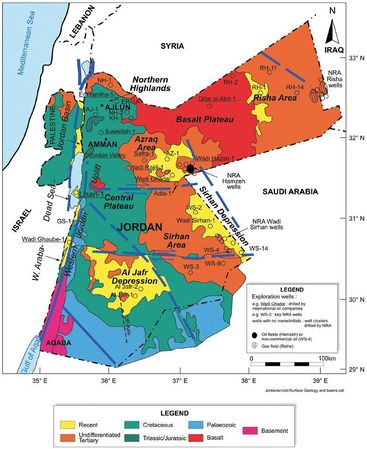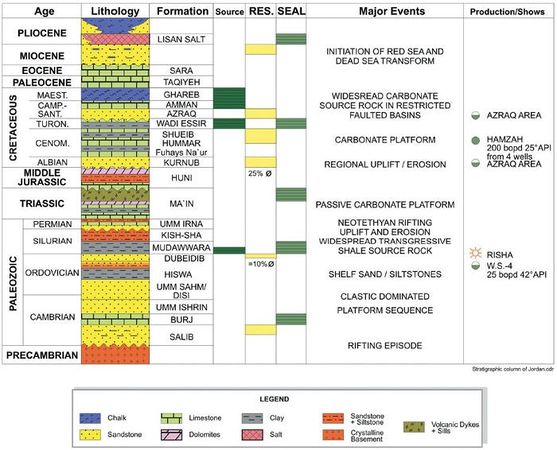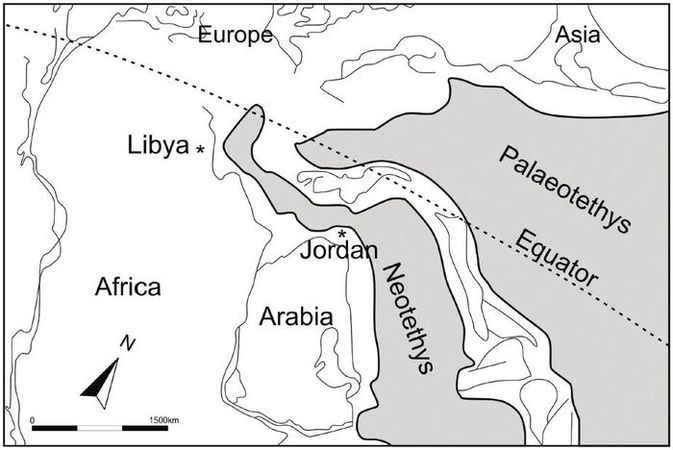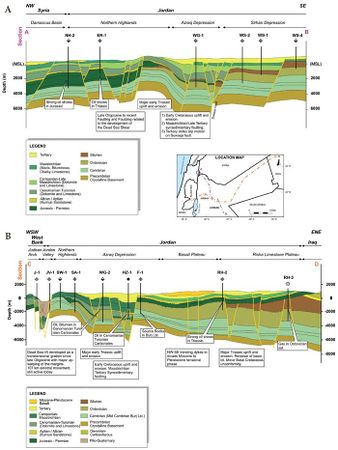Jordan petroleum geology
| Petroleum systems of the Tethyan region | |
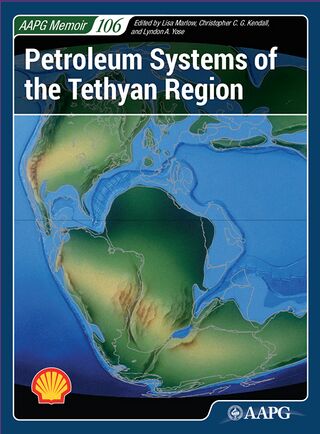
| |
| Series | AAPG Memoir |
|---|---|
| Chapter | Petroleum Geology of Jordan |
| Author | Stebastian Lüning and Jochen Kuss |
| Link | Web page |
| Store | AAPG Store |
Only two hydrocarbon fields have been discovered in Jordan so far, despite the drilling of more than 120 petroleum wells. The Silurian-sourced and Ordovician-reservoired Risha gas field in Northeast Jordan originally had a recoverable gas reserve of around 350 billion cubic feet (bcf). Since production started in 1989, almost half has already been produced. According to Jordan’s National Petroleum Company (NPC), original gas reserves of the Risha field are up to 2–3 trillion cubic feet. The same play generated oil in the Wadi Sirhan area, where small amounts of light oil were tested in Well Wadi Sirhan-4 (WS-4). The second field in Jordan is the Hamzeh oil field in central North Jordan. However, with only modest original, recoverable reserves of 1 million barrels (MMBO), of which 0.86 MMBO has already been produced at an average rate of 40 barrels of oil per day. Current exploration in the country concentrates on Maastrichtian oil shale exploration in central Jordan, where the world’s fourth largest oil shale reserves are located. Organic richness in the Muwaqqar Chalk Marl Formation partly exceeds 20%. Besides traditional open pit mining, modern in situ oil generating techniques could be applied in Jordanian oil shale exploration. The same oil shale unit also exists underneath the Dead Sea pull-apart basin, where it is deeply buried in the oil and gas generative windows. Hydrocarbon indications occur across the Dead Sea Basin and include numerous oil and gas seeps, tar sands, heavy oil, and floating asphalt blocks in Dead Sea waters and on the shoreline. Nevertheless, exploration efforts in the Dead Sea have been disappointing so far and resulted in the discovery of just a few small commercial gas accumulations which lie on the Israeli side of the basin, namely the Zohar, Kidod, and Haqanaim gas fields. Other frontier plays in Jordan include the Cambrian in the Jafr Rift and the Triassic-Jurassic in northern Jordan.
Introduction[edit]
Jordan lies to the west of Iraq and Saudi Arabia, which have some of the world’s richest oil and gas reserves. Despite this, only two hydrocarbon fields have been discovered in Jordan so far: the Silurian-sourced and Ordovician-reservoired Risha gas field in the northeastern corner of the country (Figure 1, Figure 2) and the mid-Cretaceous sourced and reservoired Hamzeh oil field in central northern Jordan.
Figure 2 Stratigraphic column of Jordan, play parameters, main tectonic events, and hydrocarbon occurrences. After NRA.[2]
The Lower Paleozoic play is restricted to east Jordan because the Silurian source rock has been eroded underneath the Hercynian unconformity in the central and western parts of the country (Figure 3, Figure 4). This erosional limit also defines the western margin of this prolific Arabian play. Besides, in the Risha area, the play is also active in central eastern Jordan in the Wadi Sirhan region, where oil shows were found in Ordovician sandstones. The mid- Cretaceous play that generated the Hamzeh field is not so well developed as in other Arabian countries. In Oman, for example, the Cenomanian–Turonian has sourced and reservoired several large oil fields such as the giant Fahud and Natih fields.[3] In Jordan, this mid-Cretaceous source rock level is thermally immature over large areas, except where deeply buried, as in the Dead Sea pull-apart rift and part of the Azraq rift graben.[1]

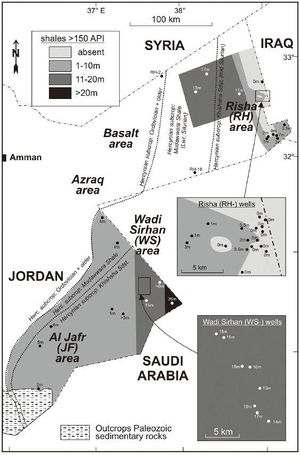
Encouraged by recent high oil prices, a number of international oil companies have now entered the country to explore the oil shale deposits themselves where they are thermally immature and close to surface. Feasibility studies have been carried out for oil shale mining and in situ production by heating.
Geological setting[edit]
Tectonics[edit]
Jordan lies in the northwestern part of the Arabian Plate, and the country’s boundaries are characterized by four major geomorphologic features: (1) the Precambrian Basement Complex to the south, (2) the Neogene Dead Sea Transform with pull-apart basins to the west, (3) the Late Cretaceous–Early Tertiary Azraq-Sirhan Depression in the east adjacent to the Saudi Arabian border, and (4) the Rutbah uplift with widespread Neogene to Pleistocene volcanics to the north (Figure 1). Four major basins exist in Jordan, including the Infracambrian Jafr rift basin in the south, the Azraq-Sirhan Graben in central eastern Jordan, the Dead Sea pull-apart basin in central western Jordan, and the (Risha) Paleozoic basin in the northeastern part of the country (Figure 1).
The Jafr rift basin was formed during the late Precambrian to early Cambrian, together with other contemporaneous extensional features across northern Gondwana. In Arabia these extensional movements are interpreted to result from escape tectonics associated with the Pan-African East African-Antarctic Orogeny (Kusky and Matsah, 2003; Jacobs and Thomas, 2004). To the south of Arabia in Oman, Infracambrian salt basins developed that were controlled by a system of transcurrent faults known as “Najd Faults”.[5] [6] [7]
Following the Infracambrian extension, the Paleozoic remained tectonically rather quiet. Only during the Late Carboniferous, compressional tectonics led to a regional tilt of the area, eroding the Paleozoic underneath the Hercynian unconformity progressively from east to west Jordan. As a result, the Silurian and Ordovician are completely absent in the western part of the country (Figure 3, Figure 4). The Late Carboniferous compressional stress is thought to originate from mid-ocean spreading east of the Arabian Plate, as the active collisional zone in North Africa was located far away in Morocco.[8]
In nearby Israel and Syria, rifting took place between Permian or Triassic and Early Jurassic, associated with the opening of the Neo-Tethys and the northward drift of Turkish-Iranian Gondwanan fragments from the Arabian plate (Figure 5). During Late Cretaceous to Tertiary several of these grabens became inverted due to Alpine collisional stress and now form the orogenic chain of the Syrian Arc (e.g., Abu-Jaber et al.[9]).
While inversion took place in the Syrian Arc region, extensional tectonics occurred in northern Jordan and led to the opening of the Late Cretaceous–Early Tertiary Azraq-Sirhan rift graben (Figure 6; Beydoun et al.[1]). Inception, age, and trend are analogous to the petroliferous Euphrates graben system of eastern Syria.[1] [10] From the mid-Miocene, major strike slip movements occurred along the Dead Sea that resulted in the creation of a series of three major west-stepping en-echelon faults with well defined pull-apart basins, that is, the Gulf of Aqaba Basin, the Dead Sea Basin, and the Galilee Basin.[1] The NNE-trending Dead Sea pull-apart basin is fairly narrow (7–10 km [4–6 mi]) and 132 km (82 mi) long.[11] Its transform fault shows up to 107 km (66 mi) of left lateral displacement.[12]
The wrenching and pull-apart basin creation is linked to the opening history of the Gulf of Aqaba, Gulf of Suez, and the Red Sea. The onset of Dead Sea movements coincides with a shift of the extensional stress regime from the abandoned Gulf of Suez toward the Gulf of Aqaba/Dead Sea transform.[13] The Neogene strike-slip faulting in Jordan also modified the structural style of the older basins further east, including the Azraq-Sirhan Basin. Neogene to Pleistocene basalts of northern Jordan were formed as a result of extensional movements in the Dead Sea transform and the Red Sea/Gulf of Suez and Aqaba systems.[14] [15]
Figure 5 Permo-Triassic paleogeographic map of the Middle East illustrating the opening of the Neotethys that was associated with major extensional movements in northern Arabia and Northeast Africa. After Stampfli and Borel.[16] 1500 km (932 mi).
Figure 6 a) Schematic east-west structural cross section from the Jordan Valley, through the northern Highlands, Azraq Depression, Basakt Plateau, and Risha Limestone Plateau to the Iraqi border. b) Schematic north-south structural cross section from the Damascus Basin through the Northern Highlands and Azraq Depression to the Sirhan Depression. After NRA.[2]

Petroleum history[edit]
The first systematic hydrocarbon exploration campaign in Jordan was carried out by the Iraqi Petroleum Company from 1947–1954, which did not lead to any drilling activity.[1] [2] Between 1955–1978, several foreign oil companies as well as the Jordanian Natural Resources Authority (NRA) explored the country with small-scale seismic, gravity, and magnetic surveys. During this phase 20 wells were drilled which did not result in the discovery of any commercial hydrocarbon field.[17] Nevertheless, oil shows in various formations indicated the existence of working plays (Figure 7). In 1981, the Jordanian government decided to increase hydrocarbon exploration efforts from treasury funds and drilled 83 wells in addition to acquiring 30,000 km (18,750 mi) of two-dimensional (2-D) seismic. These efforts resulted in the discovery of the Cretaceous-reservoired Hamzeh Oil field in 1984 in the Azraq area and the Ordovician-reservoired Risha gas field in 1987 in NE Jordan, which is close to the Iraqi border. In parallel efforts, foreign oil companies have worked in different blocks of Jordan during this phase, without exploratory success however. Today more than 100 wells have been drilled in Jordan.[1] [2]
See also[edit]
- Phanerozoic Tethys region
- Israel petroleum systems
- Libya hydrocarbon provinces
- Tethys region
- Iraq petroleum geology
- Iran petroleum systems
- Petroleum basins of Turkey
References[edit]
- ↑ 1.0 1.1 1.2 1.3 1.4 1.5 1.6 Beydoun, Z. R., Futyan, A. R. I., and A. H. Jawzi, 1994, Jordan revisited: Hydrocarbons habitat and potential: Journal of Petroleum Geology, v. 17, p. 177–194.
- ↑ 2.0 2.1 2.2 2.3 2.4 2.5 Jordanian Natural Resources Authority, 2001, Petroleum exploration opportunities in Jordan: Directorate of petroleum exploration, Amman, 56 p.
- ↑ Terken, J. M. J., 1999, The Natih petroleum system of north Oman: GeoArabia, v. 4, no. 2, p. 157–180.
- ↑ 4.0 4.1 Lüning, S., Loydell, D. K., Storch, P., Shahin, Y., and Craig, J., 2006, Origin, sequence stratigraphy and depositional environment of an Upper Ordovician (Hirnantian) deglacial black shale, Jordan - Discussion: Palaeogeography, Palaeoclimatology, Palaeoecology, v. 230, p. 352–355.
- ↑ Husseini, M. I. and Husseini, S. I., 1990, Origin of the Infra-cambrian salt basins of the Middle East, in J. Brooks, ed., GSA Special Publication: Classic petroleum provinces, p. 279–292.
- ↑ Talbot, C. J. and Alavi, M., 1996, The past of a future syntaxis across the Zagros, in G. I. Alsop, D. J. Blundell, and I. Davidson, eds., Salt Tectonics: Geological Society Special Publication, p. 89–109.
- ↑ Droste, H. H. J., 1997, Stratigraphy of the Lower Paleozoic Haima Supergroup of Oman: GeoArabia, v. 2, no. 4, p. 419–472.
- ↑ Craig, J., et al., 2008, Structural styles and prospectivity in the Precambrian and Palaeozoic hydrocarbon systems of North Africa. The geology of East Libya, Vol. IV.: Earth Science Society of Libya, Tripoli, 51-122 p.
- ↑ Abu-Jaber, N. S., Kimberley, M. M., and Cavaroc, V. V., 1989, Mesozoic-Palaeogene basin development within the eastern Mediterranean borderland: Journal of Petroleum Geology, v. 12, no. 4, p. 419–436.
- ↑ Lipson-Benitah, S., et al., 1990, Dysoxic sedimentation in the Cenomanian-Turonian Daliyya Formation, Israel, in AAPG Studies in Geology 30, p. 27–39.
- ↑ Ten Brink, U. S., et al., 1993, Structure of the Dead Sea pull-apart basin from gravity analyses: Journal of Geophysical Research, v. 98, no. B12, p. 877–894.
- ↑ Mart, Y., Ryan, W. B. F., and Lunina, O. V., 2005, Review of the tectonics of the Levant Rift system: The structural significance of oblique continental breakup: Tectonophysics, v. 395, p. 209–232.
- ↑ Bosworth, W., Huchon, P., and McClay, K., 2005, The Red Sea and Gulf of Aden Basins: Journal of African Earth Sciences, v. 43, p. 334–378.
- ↑ Ilani, S., et al., 2001, New K-Ar ages of basalts from the Harrat Ash Shaam volcanic field in Jordan: Implications for the span and duration of the upper-mantle upwelling beneath the western Arabian plate: Geology, v. 29, no. 2, p. 171–174.
- ↑ Shaw, J. E., Baker, J. A., Menzies, M. A., Thirlwall, M. F., and Ibrahim, K. M., 2003, Petrogenesis of the largest intraplate volcanic field on the Arabian plate (Jordan): A mixed lithosphere-asthenosphere source activated by lithospheric extension: Journal of Petrology, v. 44, no. 9, p. 1657–1679.
- ↑ Stampfli, G. M. and G. D. Borel, 2002, A plate tectonic model for the Paleozoic and Mesozoic constrained by dynamic plate boundaries and restored synthetic oceanic isochrones: Earth and Planetary Science Letters, v. 196, p. 17–33.
- ↑ Alsharhan, A. S. and Nairn, A. E. M., 2003, Sedimentary basins and petroleum geology of the Middle East: Elsevier, 943 p.
